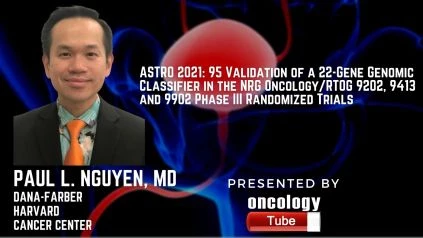Paul L. Nguyen, MD, Professor, Radiation Oncology, Harvard Medical School, Vice-Chair for Clinical Research, Genitourinary Disease Cancer Leader for Radiation Oncology, Radiation Oncology, Dana-Farber Cancer Institute, Dana-Farber|Harvard Cancer Center speaks about ASTRO 2021 Abstract – 95 Validation of a 22-Gene Genomic Classifier in the NRG Oncology/RTOG 9202, 9413 and 9902 Phase III Randomized Trials: A Biopsy-Based Individual Patient Meta-Analysis in High-Risk Prostate Cancer.
Link to Abstract:
https://plan.core-apps.com/myastroapp2021/abstract/0d611c23-3eee-4918-bdcf-3cadc805a0b7
Link to Study:
https://clinicaltrials.gov/ct2/show/NCT04513717
Objective:
Decipher is a prognostic 22-gene genomic classifier (GC) that has been prospectively verified after prostate surgery. In this study, we used three randomized phase III high-risk definitive radiotherapy trials to confirm the GC’s performance in pre-treatment biopsy samples.
Materials/Methods:Â
The highest-grade tumors were profiled on clinical-grade whole-transcriptome arrays and GC scores were obtained after central evaluation. With Cox multivariable analyses, the primary goal was to validate GC’s independent predictive potential for distant metastases (DM), followed by prostate cancer-specific mortality (PCSM) and overall survival (OS) (MVA).
Outcomes:
A total of 385 samples (n=90 on 9202, n=172 on 9413, and n=123 on 9902) received GC scores, with 265 passing microarray quality control (69%) and a median follow-up of 11 years (interquartile range, 9, 13). After controlling for age, PSA, Gleason score, cT-stage, trial, and randomized treatment arm, the GC (per 0.1 unit) was independently linked with DM (HR 1.24, 95 percent CI 1.11-1.39), PCSM (HR 1.27, 95 percent CI 1.13-1.43), and OS (HR 1.12, 95 percent CI 1.05-1.20). On MVA, those with a GC score of 0.45 (representing intermediate and high GC categories) had worse DM (HR 2.18, 95 percent CI 1.25-3.80), PCSM (HR 2.34, 95 percent CI 1.31-4.16), and OS (HR 1.45, 95 percent CI 1.03-2.04) outcomes than those with a GC score of 0.45 (representing low GC). At ten years, the cumulative incidence of distant metastasis for intermediate/high GC was 29 percent (95 percent CI 20-38 percent) compared to 13 percent (95 percent CI 7-18 percent) for low GC. At 5- and 10-years, DM was 29 percent (95 percent CI 7-52 percent) and 41 percent (95 percent CI 7-52 percent) for the subset with GC>0.85, the threshold for participation in the intensification study of NRG GU009 (PREDICT-RT), respectively (95 percent CI 17-66 percent ). In patients taking short-term or long-term androgen deprivation therapy, GC had the similar prognostic ability (ADT).
Conclusion:Â
Conclusion:Â High-risk prostate cancer is a diverse illness, and GC can help personalize shared decision-making by improving risk categorization. The NRG-GU009/PREDICT-RT (NCT04513717) trial will find the best treatment depending on the GC score.

